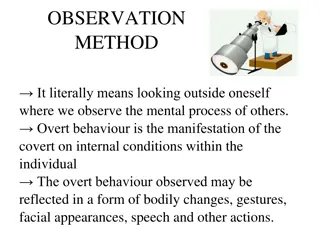Earth Observation for UNFCCC Paris Agreement Meeting
Introduction to Session 3 of the 10th CCI Colocation Meeting on Earth Observation for UNFCCC Paris Agreement. The session covers presentations, breakout sessions, and discussions on how Earth Observation can support the implementation of the Paris Agreement through case studies and future research directions.
Download Presentation

Please find below an Image/Link to download the presentation.
The content on the website is provided AS IS for your information and personal use only. It may not be sold, licensed, or shared on other websites without obtaining consent from the author.If you encounter any issues during the download, it is possible that the publisher has removed the file from their server.
You are allowed to download the files provided on this website for personal or commercial use, subject to the condition that they are used lawfully. All files are the property of their respective owners.
The content on the website is provided AS IS for your information and personal use only. It may not be sold, licensed, or shared on other websites without obtaining consent from the author.
E N D
Presentation Transcript
10th CCI colocation meeting, 9-11 Sept. 2020 Introduction to Session 3: Earth Observation for UNFCCC Paris Agreement Organizer: Michael Buchwitz, University of Bremen, Germany, buchwitz@uni-bremen.de Michaela Hegglin, University of Reading, UK Moderator: Simon Pinnock, Frank-Martin Seifert, ESA ESA UNCLASSIFIED - For Official Use ESA || Slide 1
Session 3: EO for UNFCCC Paris Agreement Agenda: 10:00 11:00: Presentations Introduction (10 min.) (Michael Buchwitz, Univ. Bremen) Global Stocktake how does it work ? (15 min.) (Florin Vladu, UNFCCC) CO2Human Emissions project (15 min.) (Gianpaolo Balsamo, ECMWF) What can EO do for the UNFCCC Paris Agreement (10 min.) (Michaela Hegglin, Univ. Reading) Q&A @ end (10 min.) 11:00 11:40: 4 Parallel Breakout Sessions Overall Objective: Brainstorming and identification of case studies on how EO can support the implementation of the Paris Agreement. Details: Next slides 11:40 12:00: Break Finalization of Breakout summaries 12:00 12:55: Feedback from Breakout Sessions ESA UNCLASSIFIED - For Official Use ESA || Slide 2
Session 3: EO for UNFCCC Paris Agreement Four Breakout Sessions (11:00 11:40, parallel): 3a: Atmospheric monitoring for quantifying GHG emissions (top-down) e.g. atmospheric retrievals of CO2, CH4, halocarbon, NO2, CO, etc., and inverse modelling to derive sources and sinks (i.e. top-down) 3b: Assessing GHG stocks, sources and sinks from observations of the terrestrial C- cycle e.g. EO-based monitoring of AFOLU, wetlands, etc., and land surface modelling to estimate emissions (i.e. bottom-up/land) 3c: Understanding the role of the oceans and polar regions as GHG sources and sink e.g. ocean circulation impact on the C sink; ocean biological carbon pump; permafrost emissions of CH4, etc. (i.e. bottom-up/oceans and ice) 3d: Use of EO in building resilience and adapting to climate change e.g. monitoring/understanding heatwaves, wildfires, and droughts; desertification; flooding; sea-level rise; sea state extreme/surge events, etc. ESA UNCLASSIFIED - For Official Use ESA || Slide 3
Session 3: EO for UNFCCC Paris Agreement Expected main output from Breakouts: Answers to these Seed questions: Q1: Identify case studies based on existing work that illustrate how EO can already support the Paris agreement. What has been done already and what can we do already now ? Q2: Are there R&D case studies that may in the next 5-10 years lead to new types of actionable information supporting Paris Agreement goals? What should we do in a follow-on programme ? Q3: How can the CCI community contribute to the first Global Stocktake in 2023? (i.e., ideas for projects in CCI+ Phase 2) What should we do in Phase 2 ? ESA UNCLASSIFIED - For Official Use ESA || Slide 4
Session 3: EO for UNFCCC Paris Agreement Breakout Sessions: How it works: The facilitators will introduce the session, compiles answers to the seed questions, guide through the session, make notes to be presented to the plenary, Baseline: Mute your phone ! If you have an input (question, comment, contribution, ): Do NOT use the HAND button Use the chat: Shortly indicate that you have a contribution, e.g., type Q or I have a question but do not formulate your detailed input in the chat If invited to speak: Press and hold the space bar to temporarily unmute ESA UNCLASSIFIED - For Official Use ESA || Slide 5
Session 3: EO for UNFCCC Paris Agreement Breakout Summary Reports to Plenary: How it works: 12:00 12:55, 4 reports + discussion: 12:00 12:40: 10 min. per report including max. 2 inputs but only from breakout participants in case the presenter has forgotten something important from the breakout 12:40 12:55: Q&A, discussion related to all 4 summary presentations ESA UNCLASSIFIED - For Official Use ESA || Slide 6
Session 3: EO for UNFCCC Paris Agreement Some remarks on CO2(likely relevant also for other variables): Current satellites not optimized to obtain information on anthropogenic CO2emissions Situation will be much better in the future thanks to initiatives from EU, ESA, ECMWF, EUMETSAT, etc. (planned CO2M satellite constellation, CHE, VERIFY, ) Nevertheless, several peer-reviewed publications addressing this important application with already existing satellites (not only CO2, but also CH4, ) Significant European contributions thanks to progress in GHG-CCI w.r.t. retrieval algorithm developments, data processing, validation, user assessments, iterative improvements, Initial GHG-CCI project: Products now generated operationally via C3S Ongoing GHG-CCI+ project: New retrieval algorithms and resulting data products from OCO-2, S5P, GOSAT-2, TanSat Paris application requires highest possible data quality (further reduction of biases, increase of data yield, uncertainty characterization, ) and assessment of fitness for purpose : Fundamental R&D to further improve retrieval algorithms etc. also important in the future ! Use of existing data products (real data !) for Paris application to find out what is possible already now & to optimally prepare for the future (here esp. for CO2M), ESA UNCLASSIFIED - For Official Use ESA || Slide 7























